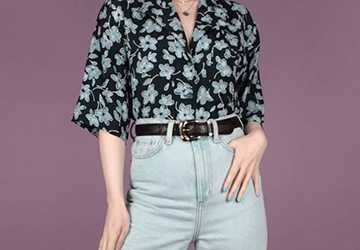Shopping for vintage attire online can be an exhilarating and fulfilling endeavour. Not only do you unearth singular pieces that distinguish your wardrobe, but you also contribute to sustainable fashion practices. Here are some top recommendations to ensure a stellar experience while buying retro clothes online.
Begin by investigating online vintage shops. Look for reviews and ratings to confirm that you're purchasing from credible vendors.
- Delve into social media and fashion blogs for suggestions on where to find the finest second-hand fashion online.

- Engage with online communities and forums focused on vintage fashion to garner insider advice on trusted online vintage shops.
Understanding your bodily measurements is imperative when buying retro clothes online. Vintage sizes often diverge from contemporary sizes, so:
- Accurately measure your bust, waist, hips, and inseam.
- Maintain a conversion chart to compare vintage and modern sizing.
- Look for size guides on online vintage shops to ensure a more precise fit.
When shopping for second-hand fashion online, meticulously read the product descriptions. Here's what to scrutinize:
- Fabric type and condition: Ensure the material is in excellent condition and meets your requirements.
- Measurements: Contrast the item’s measurements with your own to avoid sizing discrepancies.
- Pose questions to the seller about the item if the description needs clarification. Esteemed online vintage shops will be eager to provide additional details and images.
Before purchasing, always scrutinize the return policies of online vintage shops. Policies can vary greatly, and it's crucial to know:
- Whether returns are accepted if the item doesn’t fit or meet your expectations.
- The timeframe within which returns are permissible.
- Any restocking fees or return shipping costs that might apply.
Detailed photographs are indispensable when buying retro clothes online. Ensure the listings include:
- Clear images of the item's front, back, and sides.
- Close-ups of any labels, tags, and unique features.
- Images of any defects or signs of wear. Trustworthy online vintage shops will offer transparent images to give you an accurate sense of the item’s condition.
Vintage clothing often necessitates special care. Here’s how to manage your second-hand fashion online acquisitions:
- Determine if the item is machine-washable or requires dry cleaning.
- Look for care labels and adhere to the instructions meticulously.
- Invest in gentle detergents and fabric conditioners to preserve the longevity of your vintage pieces.
Please acquaint yourself with various vintage eras and their distinctive styles. This knowledge will aid you in making informed choices when buying retro clothes online:
- 1920s: Flapper dresses and beaded gowns.
- 1950s: Rockabilly dresses and circle skirts.
- 1970s: Bohemian styles and disco fashion.
Understanding these styles will help you refine your searches on online vintage shops and find pieces that resonate with your taste.
Establishing a budget is essential when shopping for second-hand fashion online. Vintage pieces can vary significantly in price based on their rarity, condition, and brand. Here are some budgeting tips:
- Set a maximum price you’re willing to pay for each item.
- Consider shipping costs, especially if you’re purchasing from international online vintage shops.
- Look out for sales and discounts offered by vintage retailers.
Ensure your transactions are secure when buying retro clothes online:
- Use secure payment methods like credit cards or PayPal, which offer buyer protection.
- Avoid direct bank transfers or paying outside the platform to minimize the risk of fraud.
- Verify if the online vintage shops have secure checkout processes to protect your personal and financial information.
One of the joys of buying retro clothes online is the ability to amalgamate vintage pieces with modern items to create a unique look:
- Pair a vintage blouse with contemporary jeans.

- Combine a retro skirt with a modern top.
- Use accessories like belts, scarves, and jewellery to blend vintage and modern styles seamlessly.
When buying retro clothes online, verifying the authenticity is paramount. Here’s how to ascertain the veracity of vintage items:
- Scrutinize provenance documentation: Reputable online vintage shops will provide the history and lineage of the item.
- Authenticate labels and insignia: Genuine vintage items frequently possess distinctive labels that denote their epoch and manufacturer.
- Utilize digital resources and compendiums to juxtapose the specifics of your item with established vintage identifiers.
Excellence is indispensable when procuring second-hand fashion online. Focus on these aspects to ensure you’re investing in resilient pieces:
- Evaluate textile calibre: Superior vintage attire is often fabricated from premium textiles that endure the vicissitudes of time.
- Inspect stitching and craftsmanship: Pay heed to the seams and stitchwork details which reflect the garment’s overall integrity.
- Select well-maintained items: Opt for pieces that have been meticulously conserved and exhibit minimal signs of deterioration.
Harness modern technology to augment your experience of buying retro clothes online:
- Employ virtual try-on tools: Some online vintage shops offer virtual fitting rooms where you can envisage how the clothing will appear on you.
- Utilize fit recommendation tools: Numerous platforms now provide tools that propose the optimal size based on your measurements and fit preferences.
Diverse vintage eras can markedly influence the price of items. Here’s a quick guide to aid your comprehension of pricing when buying retro clothes online:
- 1940s: Generally more economical, known for practical designs due to wartime fabric rationing.
- 1960s: Mid-range prices, characterized by bold, psychedelic prints and mod fashion.
- 1980s: Often more affordable, known for eclectic, extravagant styles regaining popularity.
Delve into niche markets for rare and singular finds when shopping for second-hand fashion online:
- Search for speciality online vintage shops concentrating on specific decades, designers, or fashion styles.
- Join collector groups and marketplaces where aficionados trade and vend unique vintage pieces.
- Attend virtual vintage fairs and auctions to unearth exclusive items not commonly found in mainstream stores.
Vintage shopping is inherently sustainable, but it’s crucial to ponder the broader environmental ramifications:
- Patronize online vintage shops with sustainable business practices like minimal packaging and carbon-neutral shipping.
- Opt for second-hand fashion online to mitigate the demand for new clothing production and its associated ecological costs.
- Support sellers who allocate a portion of their profits to environmental causes.
Shopping for vintage clothing online can be an exhilarating journey with unique discoveries. By following these tips, you can confidently navigate online vintage shops, ensure you're buying retro clothes online wisely, and revel in the charm of second-hand fashion online. Conduct thorough research, understand your measurements, and protect your purchases to maximize your vintage shopping experience.


